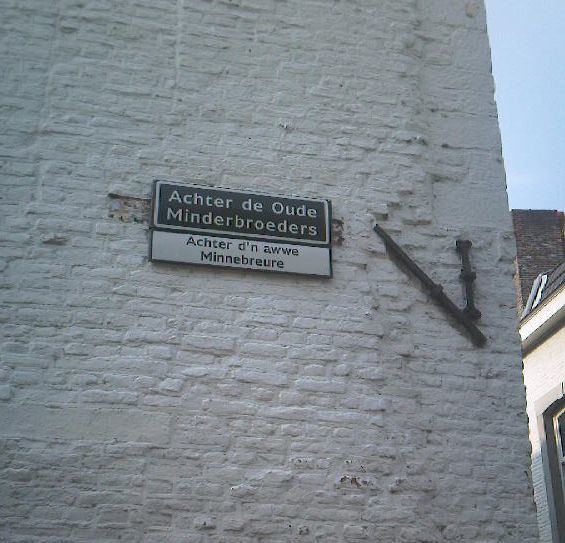Pronunciation [məˈstʀeːxs] | Native to the Netherlands Native speakers 60,000 (date missing) | |
 | ||
Language family Indo-EuropeanGermanicWest GermanicLow FranconianMeuse-RhenishLimburgishSoutheast Limburgishor Trichterlands (Central Limburgish)Maastrichtian Official language in Limburg, Netherlands: Recognised as regional language as a variant of Limburgish. | ||
Maastrichtian (Limburgish: Mestreechs [məˈstʀeːxs]) or Maastrichtian Limburgish (Limburgish: Mestreechs-Limburgs [məˈstʀeːxsˈlimbœʀxs]) is the dialect and variant of Limburgish spoken in the Dutch city of Maastricht alongside the Dutch language (with which it is not mutually intelligible). In terms of speakers, it is the most widespread variant of Limburgish, and it is a tonal one. Like many of the Limburgish dialects spoken in neighbouring Belgian Limburg, Maastrichtian retained much Gallo-Romance (or more accurately, French and Walloon) influences in its vocabulary.
Contents
- Geographic distribution social status and sociolects
- Written Maastrichtian
- Standardisation and official spelling
- Dictionaries
- Other literature on Maastrichtian
- Local anthem
- Wikimedia
- Sounds
- Monophthongs
- Consonants
- Vocabulary
- Historical Vocabulary influences from other languages
- Other examples of Maastrichtian vocabulary
- Expressions and Titles
- References
The French influence can additionally be attributed to the historical importance of French with the cultural elite and educational systems as well as the historical immigration of Walloon labourers to the city. Despite being a specific variant of Limburgish, Maastrichtian remains mutually intelligible with other Limburgish variants, especially those of surrounding municipalities.
Whilst Maastrichtian is still widely spoken, regardless of social level, research has shown that it is suffering from a degree of dialect loss amongst younger generations. That is the case in dwindling of speakers but also in development of the dialect (dialect levelling) towards Standard Dutch (like the loss of local words and grammar).
Geographic distribution, social status and sociolects
Maatrichtian being a city dialect, the terminology "Maastrichtian" (Mestreechs) is practically limited to the municipal borders, with the exception of some places within the Maastrichtian municipality where the spoken dialects are in fact not Maastrichtian. These exceptions are previously separate villages and/or municipalities that have merged with the municipality of Maastricht namely Amby, Borgharen, Heer and Itteren.
The social status of Maastrichtian speakers is determined by the type of sociolect spoken by a certain person, with a division between Short Maastrichtian or Standard Maastrichtian (Kort Mestreechs, Standaardmestreechs) and Long/Stretched Maastrichtian (Laank Mestreechs). Short Maastrichtian is generally considered to be spoken by the upper and middle classes, whilst Long Maastrichtian is considered to be spoken by the working class.
A particular feature of Maastrichtian is that it gives its speakers a certain prestige. Research of the dialect showed that people talking the "purest" form of Maastrichtian, i.e. the Short Maastrichtian (Kort Mestreechs) sociolect, were perceived by others to be the well-educated ones.
Written Maastrichtian
The oldest known and preserved text in Maastrichtian dates from the 18th century. This text named Sermoen euver de Weurd Inter omnes Linguas nulla Mosa Trajestensi prastantior gehauwe in Mastreeg was presumably written for one of the carnival celebrations and incites people to learn Maastrichtian. As from the 19th century there are more written texts in Maastrichtian, again mostly oriented towards these carnival celebrations. Nowadays however, many other sources display written Maastrichtian, including song texts not written for carnival as well as books, poems, street signs etc.
Standardisation and official spelling
In 1999, the municipal government recognised a standardised spelling of Maastrichtian made by Pol Brounts and Phil Dumoulin as the official spelling of the dialect.
Dictionaries
Other literature on Maastrichtian
Local anthem
In 2002, the municipal government officially adopted a local anthem (Mestreechs Volksleed) composed of lyrics in Maastrichtian. The theme had originally been written by Alfons Olterdissen (1865–1923) as finishing stanza of the Maastrichtian opera "Trijn de Begijn" of 1910.
Wikimedia
Sounds
The phonology of the Maastrichtian dialect, especially with regards to vowels is quite extensive due to the dialect's tonal nature.
Monophthongs
Consonants
Vocabulary
Maastrichtian contains many specific words ample or not used in other Limburgish dialects some being creolisations/"limburgisations" of Dutch, French and German words while others cannot be directly subscribed to one of these languages.
(Historical) Vocabulary influences from other languages
Maastrichtian vocabulary, as the language family it belongs to suggests, is based on the Germanic languages (apart from the Limburgish language family this also includes varying degrees of influence from both archaic and modern Dutch and German). However, what sets Maastrichtian apart from other variants of Limburgish is its relatively strong influences from French. This is not only because of geographic closeness of a Francophone region (namely Wallonia) to Maastricht but also because of French being the predominant spoken language of the Maastrichtian cultural elite and the higher secondary educational system of the region in the past. Some examples:
Other examples of Maastrichtian vocabulary
Some examples of specific Maastrichtian vocabulary:
Expressions and Titles
Some examples of Maastrichtian expressions:
